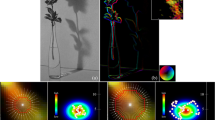Abstract
This paper introduces a scale-invariant and contrast-invariant multi-scale differential edge detector. The method is a direct consequence of two key discoveries: (1) a precise scale normalization method and (2) a formula to verify scale-invariant detectors. The new scale normalization method provides differential operators with respect to scale, among them the scale-invariant edge detectors. To investigate these differential detectors quantitatively, mathematical functions were used to represent the edges and to solve for the parameters, including position, width, contrast, offset, and orientation, in closed form. Noise is filtered as a low-contrast feature. The method has been tested with various kinds of synthesized edge functions and can extract edge features accurately. It is suitable for real-world images of several kinds of degradation.





















Similar content being viewed by others
References
Canny, J. (1986). A computational approach to edge detection. IEEE Transactions on Pattern Analysis and Machine Intelligence, 8(6), 679–698.
Feynman, R. P., Leighton, R. B., & Sands, M. (1964). The Feynman lectures on physics. Reading, MA: Addison-Wesley.
Gebäck, T., & Koumoutsakos, P. (2009). Edge detection in microscopy images using curvelets. BMC Bioinformatics, 10, 75.
Guo, C., Zhu, S. C., & Wu, Y. N. (2007). Primal sketch: Integrating structure and texture. Computer Vision and Image Understanding, 106(1), 5–19.
Hajiaboli, M. R., Ahmad, M. O., & Wang, C. (2012). An edge-adapting Laplacian Kernel for nonlinear diffusion filters. IEEE Transactions on Image Processing, 21(4), 1561–1572.
Ham, B., Min, D., & Sohn, K. (2012). Robust scale-space filter using second-order partial differential equations. IEEE Transactions on Image Processing, 21(9), 3937–3951.
Haselhoff, A., & Kummert, A. (2012). On filtering by means of generalized integral images: A review and applications. Multidimensional Systems and Signal Processing, 23(1), 291–312.
Hu, Q., He, X., & Zhou, J. (2005). Multiscale edge detection with bilateral filtering in spiral architecture. In Proceedings of the Pan-Sydney area workshop on visual information processing (pp. 29–32).
Koenderink, J. J. (1984). The structure of images. Biological Cybernetics, 50(5), 363–370.
Kokkinos, I., Maragos, P., & Yuille, A. (2006). Bottom-up & top-down object detection using primal sketch features and graphical models. IEEE Computer Society Conference on Computer Vision and Pattern Recognition, 2, 1893–1900.
Lindeberg, T. (1998). Edge detection and ridge detection with automatic scale selection. International Journal of Computer Vision, 30(2), 117–154.
Liu, X., Wang, C., Yao, H., & Zhang, L. (2012). The scale of edges. In IEEE conference on computer vision and pattern recognition (CVPR) (pp. 62–469).
Mahmoodi, S. (2011). Scale-invariant filtering design and analysis for edge detection. Proceedings of the Royal Society A: Mathematical, Physical and Engineering Science, 467(2130), 1719–1738.
Mairal, J., Leordeanu, M., Bach, F., Hebert, M., & Ponce, J. (2008). Discriminative sparse image models for class-specific edge detection and image interpretation. ECCV, Lecture Notes in Computer Science, 5304, 43–56.
Marr, D., & Hildreth, E. (1980). Theory of edge detection. Proceedings of the Royal Society of London Series B, Biological Sciences, 207(1167), 187–217.
Miller, E., & Willsky, A. S. (1997). Multiscale, statistical anomaly detection analysis and algorithms for linearized inverse scattering problems. Multidimensional Systems and Signal Processing, 8(1), 151–184.
Verma, O. P., Hanmandlu, M., et al. (2013). A novel fuzzy system for edge detection in noisy image using bacterial foraging. Multidimensional Systems and Signal Processing, 24(1), 181–198.
Witkin, A. P. (1983). Scale-space filtering. In 8th International joint conference on artificial intelligence (vol. 2, pp. 1019–1022).
Yi, S., Labate, D., Easley, G. R., & Krim, H. (2009). A shearlet approach to edge analysis and detection. IEEE Transactions on Image Processing, 18(5), 929–941.
Yu, P., Qin, A. K., & Clausi, D. A. (2012). Unsupervised polarimetric SAR image segmentation and classification using region growing with edge penalty. IEEE Transactions on Geoscience and Remote Sensing, 50(4), 1302–1317.
Author information
Authors and Affiliations
Corresponding author
Rights and permissions
About this article
Cite this article
Zhang, X., Liu, C. An ideal image edge detection scheme. Multidim Syst Sign Process 25, 659–681 (2014). https://doi.org/10.1007/s11045-013-0224-9
Received:
Revised:
Accepted:
Published:
Issue Date:
DOI: https://doi.org/10.1007/s11045-013-0224-9




